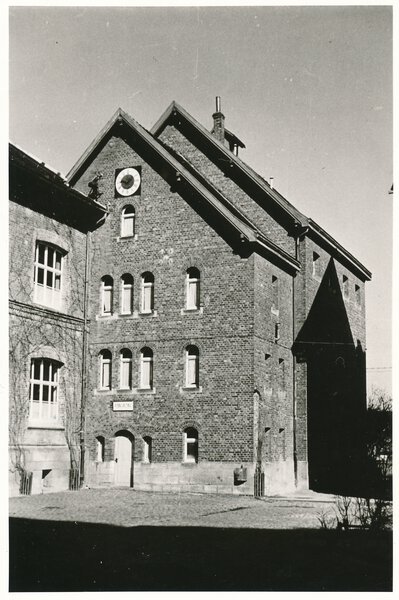Work education camp (Arbeitserziehungslager) 1940-1945
The facility until 1940
The Breitenau state workhouse and state welfare home (Landesarbeitsanstalt und Landesfürsorgeheim Breitenau) continued to exist throughout the entire Nazi period. The repressive treatment of inmates that had already begun at the outset of the facility was becoming increasingly violent. New and amended laws intensified the criminalization of socially marginalized peoples and formed the basis for their persecution. Much of the staff, first and foremost the director, willingly implemented these laws. On the basis of the law for the prevention of offspring with hereditary diseases (Gesetz zur Verhütung erbkranken Nachwuchses) of 1934, at least 21 inmates of the Breitenau facility had been forcibly sterilized by 1939. In addition, many of the persons that had to undergo correctional measures (Korrigenden) were considered "workshy" (arbeitsscheu) and fell within the jurisdiction of the administration of justice. Beginning in the late 1930s, these persons were transferred from Breitenau to the Rodgau-Dieburg prison camp in southern Hesse, which was known as an extremely harsh and brutal prison. As a result of the transfers, the number of prisoners in the state workhouse (Landesarbeitsanstalt), as it had been called since 1934, decreased, thus freeing up capacity. In November 1938, the facility temporarily served as a detention centre for Jews from Guxhagen and the surrounding area who were detained there during the November pogroms. After the end of 1939, the Gestapo Kassel had prisoners committed into the facility and thus it became a kind of alternative police prison (Polizeiersatzgefängnis).

Establishment of the work education camp (Arbeitserziehungslager)
In May 1940, the Gestapo Kassel officially set up the Breitenau work education camp. A total of 8,304 prisoners were detained there until the camp was dissolved in March 1945.
"Work education camps" were Gestapo camps which the historian Gabriele Lofti describes as "the concentration camps of the Gestapo" and "sites of terror". In contrast to the SS concentration camps, from which releases were no longer issued after the beginning of the war, imprisonment in the work education camps was for a limited period and usually lasted between six weeks and three months. However, during this period, the Gestapo was able to request a transfer to a concentration camp which meant that the Breitenau work education camp also had the function of a transit concentration camp (Konzentrationssammellager).
The Breitenau work education camp notably stood for the control and punishment of forced workers who were put to work in the district of Kassel: 80% of the Breitenau work education camp prisoners were foreign forced workers. These persons had been abducted from countries occupied by Nazi Germany for the purpose of forced labour or lured into the German Reich by means of false promises. Violating the regulations formulated in the racist decrees regarding Polish and Eastern European workers (Polen-Erlasse and Ostarbeiter-Erlasse), for example, meant the threat of imprisonment in a work education camp. In addition to foreign forced workers, German Gestapo prisoners were also imprisoned in the Breitenau work education camp. Such persons were accused of "violations against the norms of the national community" (Verstöße gegen die Volksgemeinschaft). Among them were German women persecuted for "illicit encounters" with foreign forced workers, as well as Jews who would be transferred from the Breitenau work education camp to the concentration camps of Ravensbrück, Buchenwald, Sachsenhausen or Auschwitz.
The prisoners were made to execute hard physical labour of up to 12 hours per day while receiving utterly insufficient rations and care. Imprisonment in work education camps served as a punishment as well as a deterrent and disciplinary measure; the will to resist was meant to be broken amongst forced workers in particular. Among the prisoners of the Breitenau work education camp, the following 26 persons died from causes related to prison conditions. Four persons lost their lives while performing forced labour. Three prisoners took their own lives, and in the case of two deceased persons, the causes are unknown. In addition, the Gestapo murdered a total of 81 prisoners; among them were 28 persons who became victims of the so-called "end-phase crimes" that took place in the vicinity of the camp just shortly before liberation.
